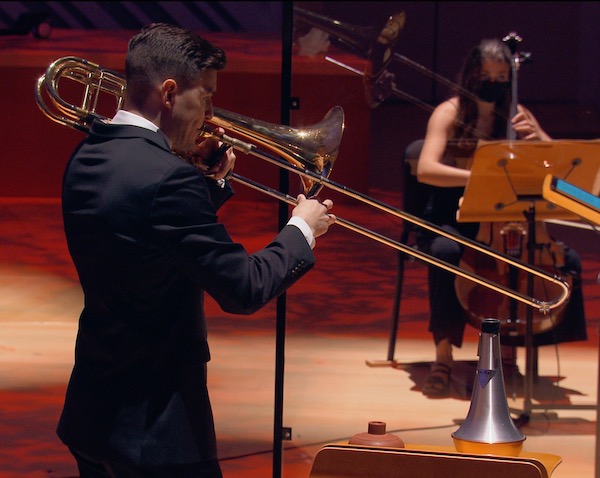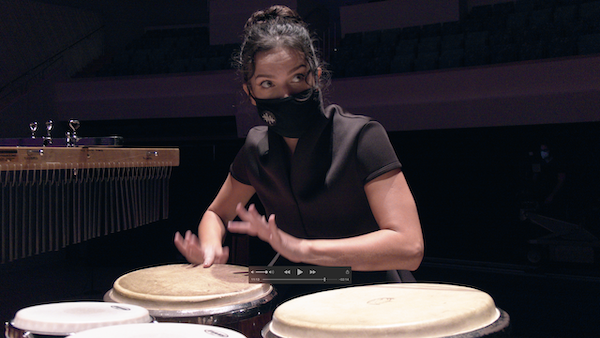New World serves up a varied chamber feast with emphasis on the modern

Since its initial flowering under Haydn, the quartet has proven one of the most inventive and durable forms for classical composers across the centuries.
Sunday afternoon’s New World Symphony chamber music concert, streamed on IDAGIO, offered two outstanding examples of that enduring creativity from the 19th and 21st centuries. Quartets by Antonin Dvořák and Caroline Shaw were the high points of a stimulating 90-minute program.
Dvořák wrote his Quartet No. 2 in E-flat Major for piano and strings in 1889, three years before he would take a ship to America and begin a new chapter in his and the nation’s musical life. This piano quartet decisively comes from the composer’s Czech roots. In the opening Allegro con fuoco, the initial theme is abruptly stated but quickly morphs into a warmly inviting folk-tinged melody. Thomas Steigerwald’s light pianistic touch aptly served the bright melody but he showed ample power for the big moments. The edgy intensity and thrusting momentum of the four musicians made the entire movement sound fresh and revitalized.
The mellow sound of Chava Appiah’s cello radiated the nostalgia of the Lento’s principal theme, the relaxed tempo bringing out the melody’s expansive lyricism (while not neglecting the storm and drama of the central section). The third movement Allegro moderato is one of those irresistible Czech waltz tunes that Dvořák uniquely conceived and it was rendered with salon-like intimacy and aristocratic élan. The trio section suggests the composer’s Slavonic Dances and with Steigerwald’s fleet articulation and the strings really digging in, fiery momentum abounded in this interlude.
The players bought high-wire tension to the concluding Allegro ma non troppo. Despite the rapid tempo, individual instrumental parts came through with transparent clarity. Violinist Yefim Romanov’s brio and violist Jacquelyn O’Brien’s deep tone contributed fully to this exciting performance. At the conclusion, Steigerwald gave his collaborators a thumbs up, and the camera work skillfully captured the interaction between the masked, socially distanced musicians.
In 2013 Caroline Shaw became the youngest composer ever to win the Pulitzer Prize (for her Partita for 8 Voices). The same year she wrote Punctum, the first of a continuing series of string quartets. In her introductory remarks, Shaw related that she was deeply moved by an introductory chord of a chorale in a performance of Bach’s St. Matthew Passion.
The main thematic material of Punctum is based on that Baroque model. Still, the nervous figurations and sudden extended melodic outbursts resound in a quintessentially American voice (suggesting Walter Piston or Copland).
While only nine minutes long, Shaw packs a wide array of incident and invention into this worthy addition to the quartet literature. When the full Bach chorale is stated in the score’s final pages, an aura of solace seems to emerge from darkness and strife. The rich sonority of violist Marlea Simpson and cellist Vivian Chang complemented violinists Sergio Carleo and Brandon Elliott’s terse attack in the more astringent moments.

The program opened with Song for Sister Hokkaido by Frederick Tillis for brass ensemble and percussion. Like many scores for that instrumentation, jazz and pop influences shine through the musical fabric. While pleasant enough to listen to, the brief work is lacking in memorable thematic or structural distinction. Tillis did, however, write a standout part for the percussionist and Marcelina Suchocka was simply terrific whether playing bongos and chimes in extended solos or supporting the ensemble with a firm hand. Morgan Low and Aaron Ney’s virtuosic trumpets were first among equals.
Ian Dicke’s O Bury Me Not was commissioned by the New World Symphony and premiered in 2013. Taking its inspiration from the song “O Bury Me Not on the Lone Prairie,” the work mixes live electronic processing with solo bass trombone and a 7 piece ensemble. As Dicke pointed out in his pre-performance comments, the song originated in the 1830’s as a sea shantey and later became a western standard (in pre-country-music days).
Taking a 1939 field recording by Texas singer Frank Goodwyn made by legendary folk musicologist John Lomax, the static and surface noise on the recording become part of Dicke’s instrumental texture. The rarely utilized bass trombone provides wry, sad and sarcastic commentary and the piece brims with imagination. Michael Linville conducted a taut performance, aided by a flickering film of the West. Noah Roper was masterful in the bass trombone solo role, his slides and growls as compelling as the melodic moments.
The New World Symphony presents the James Ehnes Bach Project with NWS fellows playing six unaccompanied violin works by J.S. Bach. 7:30 p.m. December 12, streamed on IDAGIO. nws.edu
Posted in Performances
Leave a Comment
Mon Nov 16, 2020
at 2:34 pm
No Comments